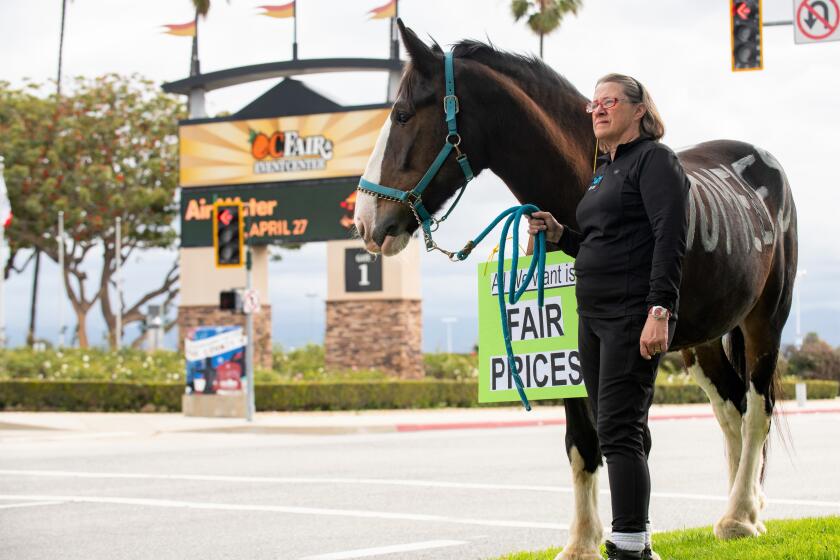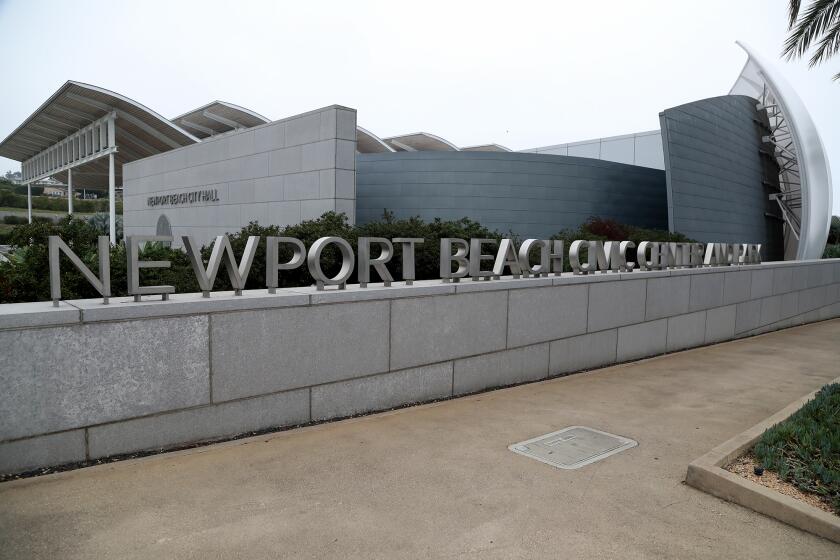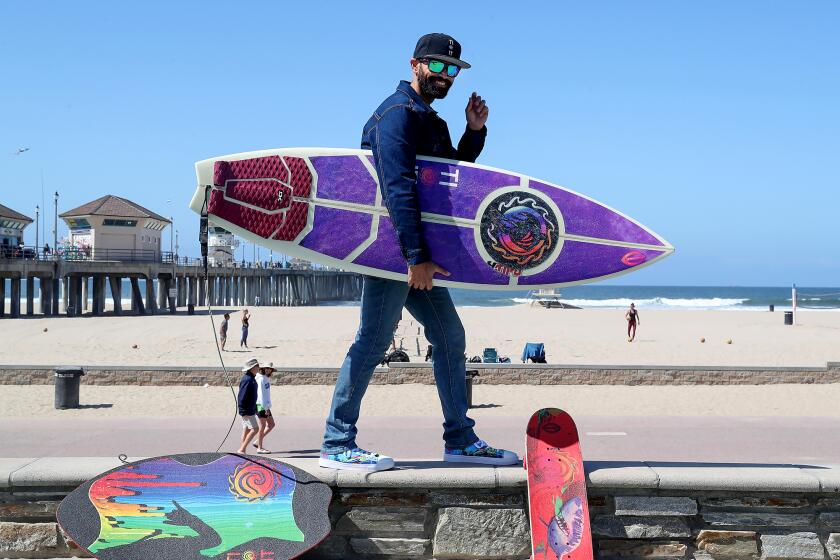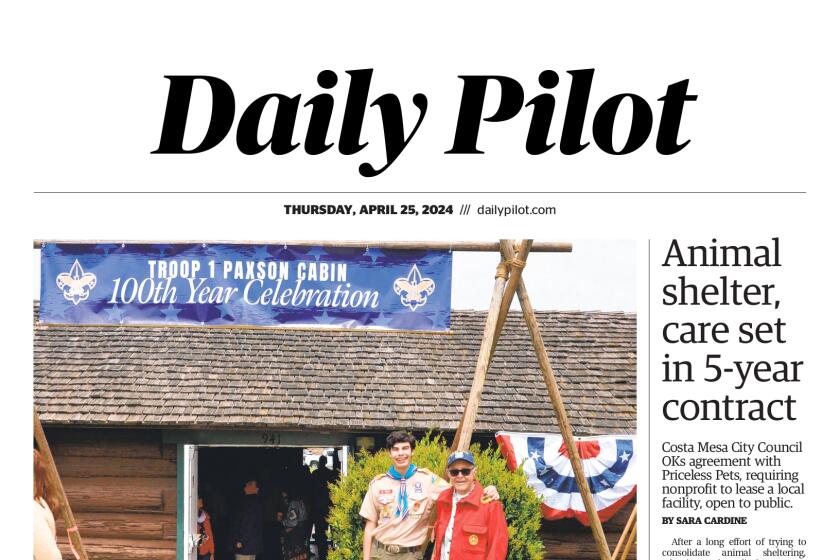Mailbag: Cartoonist feels loss of Frank Interlandi
Laguna lost an artist, and my profession lost a master. Frank Interlandi passed away last week. Now I didn’t know Frank personally, but I wish I had met him at least once.
His generation of cartoonists was an inspiration to me, and I would have liked to tell him. In fact, my enjoyment of his masterpieces is the reason I wanted to be a cartoonist. It is important to acknowledge the debt we owe to our predecessors in the arts.
Interlandi’s genius is that he communicates his mind and feelings in one panel. Artistically he brings a painterly brush stroke to a medium that was previously owned by Zippatone and etching style. I do not speak of him in the past tense; I cannot because he lives on his art.
Every artist puts a bit of themselves in their work. It is the artist’s path to immortality. Interlandi’s work will be admired, studied and felt centuries from now.
His work on Robert Kennedy’s death is as moving today as it was more than 30 years ago. A true artist, he observed society as a whole, not focusing on politics.
MICHAEL LUKASH
Santa Ana
Editor’s Note: Lukash is a cartoonist for the Coastline Pilot.
Government must address cell towers
Opposition to the construction of the cell tower on Top of the World did not go unnoticed, at least for now. City Manager Ken Frank requested that the City Council remove the item from the agenda on Feb. 2. His recommendation was to avoid construction at the proposed location at Fire Station No. 3. The options for T-Mobile now are not to move forward with the construction, find another suitable location on private property, or build the tower on a public right-of-way.
What should be clear is that the opposition to the construction was not based on aesthetic concerns to the 36-foot-high pole disguised as a eucalyptus tree, a design city staff suggested [as] “being a natural look that best fits the current landscaping.” Nor was it because of the possible adverse effect on property values, but instead as a valid concern for the potential harmful effects being caused by this technology.
There are genuine reasons for concern as evidenced by all the data published. Over the last four years, it has been found that there is an increased risk of developing brain tumors among people who used cell phones for longer than 10 years.
Multiple studies also reported that as head size decreases, the percentage of energy absorbed by the brain increases (Martinez-Burdalo 2004). That is why children absorb more radiation than adults do. Children’s tissues also have a higher amount of water and ion content compared to those of adults (Peyman 2009), making them even more vulnerable to radiation.
There is also convincing research to prove significant health problems in people living within 300 meters of a cell tower (Santini 2002), or the Spanish study called “The Microwave Syndrome” that found adverse health effects, from those living near two cell-phone stations.
So before a new site is selected, my argument is that “business as usual” is no longer possible if children’s health is at risk. That placement of wireless technology is likely to be a risky business. The prudent course of action is to minimize exposure whenever and wherever possible.
There is one thing where all sides agree, and that is research must continue to define what levels of exposure are acceptable.
What is clear is that the need for more research should not delay action. Therefore, while new limits are being developed and implemented, the only reasonable approach is to set the limits below the exposure levels linked to childhood leukemia, plus a reasonable safety factor.
While it is not possible to move the school, we can avoid construction of new lines that place people in environments that have been determined to be risky. I am arguing for an end to tower proliferation near schools, or places where children spend time.
Today electromagnetic fields are all around us. With 4 billion people using cell phones, we don’t even need to own one to be exposed.
Radiation is everywhere from a variety of sources, from the Earth’s magnetic fields to man-made sources of non-ionizing EMF generated by electric wiring in our homes, from sunlight containing infrared and ultraviolet frequencies to magnetic resonance scanners extensively used in medicine.
With the appreciation of the benefits that this technology brings to our lives, the mobile telephone industry has grown rapidly, and a network of electric currents generates EMFs all around us. However, the mounting evidence that radiation might adversely affect health leads to the belief that exposure in our everyday life must be controlled.
For the sake of the world as a whole, I hope that “we the people” respond to the special interests that helped to write the legislation that became law “” the Telecommunication Act of 1996 that basically states that local authorities can’t regulate the placement of or ban these towers “” defending our right to have a voice and a vote in matters of public concern.
We must hold lawmakers accountable for giving the industry freedom to install towers wherever they want. Doing this will strengthen our local officials to represent us and protect the welfare of the community.
In any case, one thing is clear: We have not only the right, but the obligation to protect our children and ourselves.
GUSTAVO GRAD
Laguna Beach
‘Radio WHIK’ shows off local talent
Again our No Square Theatre presented another first-class show last weekend! What a privilege to enjoy the professional talent, energy and delightful music of “Radio WHIK Back on the Air! Part 2” show. We appreciate the dedication of so many talented folks who contribute to community theater here.
My Midwestern livin’ and visitin’ sister-in-law commented, “Wow! That was just an amazing amount of talent on display you have here!”
To which we explained with pride and enthusiasm that no, this was wonderful, but no exception. We also enjoy with regularity the ongoing sophisticated performances of Lagunatics and ABBAsolutely Fabulous, to name two in just this past year. Indeed, it is a privilege. Thank you! Ya’ll come back soon.
EARLE and LAURA WELLSFRY
Laguna Beach
Of loaves, fishes a nd the homeless
The Lukash cartoon on Feb. 5’s Forum page asked, “If Jesus fed the multitude in Laguna Beach today”¦” and it was answered by a City Council character with, “Could you move this to the shelter?”
I would have answered more appropriately with, “Could you move this to one of your 10 or so Laguna Beach churches (listed in the same issue)?” The problem with that would be, which of the 10 or so churches, if any, Jesus would pick as his one and only true church? Maybe the shelter isn’t such a bad idea after all.
NIKO THERIS
Laguna Beach
Tunnel project should be stopped
The tunnel that a major engineering firm deemed feasible recently is actually a two-tunnel project. The engineers were paid to justify and rubber stamp it by the combined transportation agencies of Riverside and Orange counties, and this insanity should be abandoned, now.
The first phase is estimated at $8.6 billion, the second phase dependent upon funds generated by the first, if you read the fine print. So who wants to write a blank check that doesn’t guarantee a finished product? Would the proponents of this fiasco in progress buy a car without a set final price and warranty? I don’t think so.
Whether or not the funds come from county, state and/or federal coffers, taxpayers need to stop these people from spending even more hundreds of millions in preliminary studies, throwing good money after bad. This is unconscionable in our economy.
First, as they found out in Boston at the Big Dig, once the hole is dug there’s no turning back, no exit strategy, and costs start soaring exponentially. Big Dig went from the original $2.8-billion estimate to about $22 billion, and it still isn’t safely completed. So these things are really “guesstimates.” If it were a car, the public (including federal taxpayers) is being coerced by government to buy a possible lemon on trust.
Boring a few holes in an 11.5-mile mountain isn’t adequate to assure us, and unless the engineers have Superman with his X-ray vision on their staff, this is a leap into the unknowable.
Second, just because engineers believe that it can be done doesn’t mean it should. Monolithic structures experience monumentally catastrophic failures. The 7.5-mile long Mont Blanc Tunnel had a fire that took 39 lives in 1997 due to a failed ventilation system.
In the case of our tunnel, earthquake seems a more likely scenario. There are numerous major and minor fault lines in the vicinity, so loss of electrical power could leave motorists or transit passengers in a pitch-black panic. Seismologists project that every day which passes puts us closer to major seismic events in the area.
One is tempted to ask the engineers and public officials if they’ll agree to go there to help dig out the dead and maimed bodies from the rubble with their bare hands a la Haiti, go to the homes of the unnecessary victims and tell their loved ones of the tragic news.
Third, these people from the Orange County Transportation Authority have short, convenient memories. Just as the 241 Toll Road became a Pac-Man, gobbling up millions in its failed attempt, this tunnel will get the same type of eco-scrutiny and legal challenges by coalition groups with staff attorneys themselves. The environmental disruption for environmentally sensitive habitat, for threatened and endangered species while under construction, the long-term eventual impacts to the same list when completed will protract the permitting process. That scenario could become interminable, thus also driving up costs for attorneys in federal courtrooms.
The sheer complexity of the enviro-impacts will become its own cottage industry for consultants and lawyers. Costs will soar higher than any indigenous flying raptors above the forest.
Fourth, it’s basically a bureaucratic Ponzi scheme: Projected funds from the first phase will purportedly fund the second. If the first phase costs climb significantly, if it doesn’t generate the projected revenue profit after opened, or if the first tunnel fails either during or after construction, then the second becomes science fiction. Gambling with taxpayer money is what caused our bankruptcy in the first place; don’t these officials learn from their mistakes? Using a “Field of Dreams” build-it-and-they-will come logic is fiscally irresponsible and myopic.
Last, if in the process of tunneling funding dries up, unpredicted physical features create problems that require additional studies and stalls the project, or that seismic cataclysm occurs, leaving taxpayers with a pile of worthless, useless rocks and dirt, what is the contingency plan, the fall-back point financially? What insurance underwriter is nuts enough to protect our funds?
This really isn’t much different than our Orange County bankruptcy in 1994. This is fiscally very risky, potentially another black hole or money pit using the public’s money.
Yes, it may be possible, but what they aren’t admitting is that it probably will take forever, cost indeterminate amounts of money, and could cause incredible loss of life if it fails during peak rush-hour traffic. Do they think we, the public, who will pay for this engineering fantasy, are that gullible?
ROGER VON BÃœTOW
Laguna Beach
All the latest on Orange County from Orange County.
Get our free TimesOC newsletter.
You may occasionally receive promotional content from the Daily Pilot.



